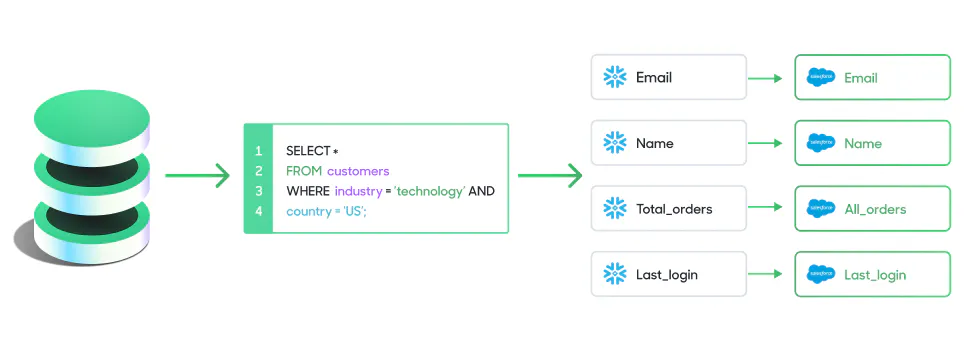 Getting the right people to notice you is key to growing your small business.
Getting the right people to notice you is key to growing your small business.
That’s why many small business owners build a social media presence to market their brands.
Whether you’ve just started your business or are looking for more ways to attract leads, social media gives you the perfect outlet to find your people.
But you need a tailored approach and the right content to draw in potential customers.
Let’s take a look at some strategies you can implement to do just that.
Use data better to improve your targeting approach
Understand your target customer better and create relevant content by digging deep into their data and behavior.
This is where reverse ETL (extract, transform, load) can help.
Reverse ETL lets you take data from your business systems and send it to your marketing platforms.
For example, you can sync customer purchase data from your internal databases to your social media ad platforms. This helps you create more targeted and personal marketing campaigns based on actual customer behavior. (See the graphic below)
For instance, you might learn that your Gen Z customer group is the audience segment that buys your eco-friendly skincare products the most. When planning your social media campaigns, you can target your eco-friendly content toward that specific audience segment. (Especially when running ads.)
Protecting your data is also crucial in this process. Using reliable backup options like AWS (Amazon Web Services) and aws etl tools can keep your data safe. Consider AWS backup costs and other options to find the best solution for your business.
Schedule micro-influencer campaigns in your content calendar
Lock arms with micro-influencers who target the same audience you do — and work together often.
Micro-influencers charge affordable prices and have ultra-niche audiences that like and trust them. This gives you a great opportunity to present your business to relevant prospects who are ready to buy.
To encourage more eyes on your business, collect contact information, and nudge leads to conversion, have your partners:
Run user-generated content (UGC) campaigns to generate awareness and social proof
Run contests and giveaways to generate awareness and boost virality potential
Use lead magnets like downloadable guides to grab email opt-ins
Use lead magnets, like coupon codes, to encourage sales
*Pro tip: Manage the full lifecycle of your influencer marketing campaigns with HypeAuditor. Discover influencers, analyze metrics, manage campaigns, and explore markets — all in one spot. Sign up for free or request a demo now.
Kate Andreeva, Head of Influencer Talent Relations at HypeFactory: “Micro-creators create an authentic and friendly connection with their audience by publishing niche content. They are virtually the only source of information on narrow topics that are rarely covered by celebrities or media outlets. This makes them attractive to brands with limited budgets and targeting highly relevant consumers with a genuine interest in their product or service. This pays off for brands with higher ROI and higher conversion rates.”
Run UGC campaigns
Encourage and entice your customers to create and then share content related to your brand. It’s a great way to tap into their networks and widen your reach.
These genuine experiences help build trust and community among your followers. Real-life use cases are also incredibly persuasive and can significantly influence potential customers.
The simplest way is to create a hashtag campaign that your customers can use when posting about your products or services. This also makes it easy for you to track and share their content. (Check out CruiseAmerica’s UGC feed using its #BeThereNow hashtag below!)
To encourage people to join, consider running contests or giveaways in which customers can send photos, videos, or reviews to win prizes.
Share the UGC you’ve collected across all of your social media accounts, and give credit to the original creators. (Make sure you have their permission first.) This boosts their confidence and loyalty and encourages others to contribute. You can also integrate it throughout your ads, email marketing campaigns, and website.
*Pro tip: Create UGC ads to boost virality potential. UGC already helps you build trust with top-of-the-funnel leads. By building ads around it, you can encourage more views and (hopefully) spark a frenzy.
Publish informative videos or tutorials on YouTube
Create and share tutorials or educational videos on YouTube to establish your business as an authority in your industry.
These also help attract potential customers who are searching for insights related to the topics you’re covering, and you can even use an AI video generator from image to turn static visuals into engaging explainer videos.
Before shooting these, identify topics aligning with your search intent and expertise.
For instance, if you sell custom men’s fashion, like suits and tuxedos, your target audience might search for questions, such as:
How to choose the right colors when choosing a wedding suit
What to ask for when ordering a custom men’s suit
How to properly put on a men’s tuxedo and bowtie
Tuxedo versus suits — which one’s right for me?
Depending on the topics you’re covering, your video content types might include:
How you make a product behind-the-scenes
Product demonstrations
Informative overviews
Specific tutorials
Industry tips
For instance, in the following example, SoFi posted a helpful video on its YouTube channel about options trading for beginners.
It also mentioned the YouTube video in a blog post about options trading to give it more chances to be seen in search engine results pages.
Another way it could use this video is by publishing it in an email campaign or on a relevant landing page.
Here are some more helpful tips to keep in mind when planning your YouTube videos:
Post quality videos
Invest in quality production to keep your videos visually appealing and professional. While you don’t need high-end equipment, make sure to prioritize good lighting, clear audio, and thoughtful editing.
Don’t forget about SEO
Use relevant keywords in your social media titles, descriptions, and tags. This helps your content appear higher in social search results and attract viewers looking for information on those topics.
Include an engaging thumbnail and a call-to-action in your videos to boost engagement and drive traffic to your website (along with your other social media channels).
Stay active and engage with commenters
Regularly upload content to your YouTube channel to keep your audience engaged and encourage them to return for more.
Respond to comments in a timely manner and interact with your viewers to build a community around your brand.
*Pro Tip: Use YouTube Analytics to track video performance. It’s a crucial way to gain insights into your audience’s preferences. Use this data to guide your social content strategy and create more long-form videos that resonate with your viewers.
Post helpful carousels
Share informative mini-guides (or carousels) that position your brand as an authority and deliver value to your audience. By breaking down complex information into bite-sized, visually appealing slides, your content can be more digestible and engaging for your followers.
Identify topics that align with your offerings and your audience’s needs and pain points.
For example, if your business helps new entrepreneurs register their businesses, make slides explaining different business entities, like sole proprietorships, partnerships, LLCs, and corporations.
Take your carousels a step further by offering state-specific guidance. For instance, “How to form an LLC in Texas.” Outline the necessary steps, required documents, and any state-specific regulations.

(Image Created in Canva)
Design your carousels with clear, concise text and visually appealing graphics to engage viewers. Use a consistent format and style that aligns with your brand’s aesthetic. Include calls to action, like visiting your website for more detailed guides or contacting you for help.
*Pro-Tip: Use a design tool like Canva to create professional-looking carousels quickly. Simply choose a template that stands out to you and customize it to fit your brand’s needs.
Create a consistent posting schedule
Always post high-quality content that keeps your brand at the forefront of your audience’s mind and encourages ongoing engagement.
Build a content calendar that outlines what you’ll post and when.
This calendar should include a mix of media like promotional content, educational posts, user-generated content, and behind-the-scenes glimpses into your business. By varying your content, you can keep your audience interested and engaged.
It’s also important to focus on videos encouraging social media platforms to share your content. These include B-Roll and Talking Head videos on Instagram and TikTok. Try to post one to three of these per day. Improve your video social media strategy by tracking engagement metrics.
Don’t forget about your audience. Engage by responding to as many comments and messages as you can within 24 hours. Thank them for their help and encourage more interactions by asking them questions or starting discussions in your posts. The more you interact with your followers, the more relationships you’ll build.
*Pro Tip: Stick to your posting calendar by using social media management tools. Software like Buffer or Hootsuite can schedule your posts in advance.
Wrap up
Social media gives you the chance to connect with millions of aligned prospects, especially if you track your campaigns to learn more about what works — and double up on those tactics.
Speaking of tactics, the strategies we covered in this guide include:
Use data better to improve your targeting approach
Schedule micro-influencer campaigns in your content calendar
Run UGC campaigns
Publish informative videos or tutorials on YouTube
Post helpful carousels
Create a consistent posting schedule
For more tips and tricks on how to use social media marketing for small business success, check out uSERP's blog.
That’s it for now. Here’s to your success across all types of content and social platforms!


 (
( (
( (
(









